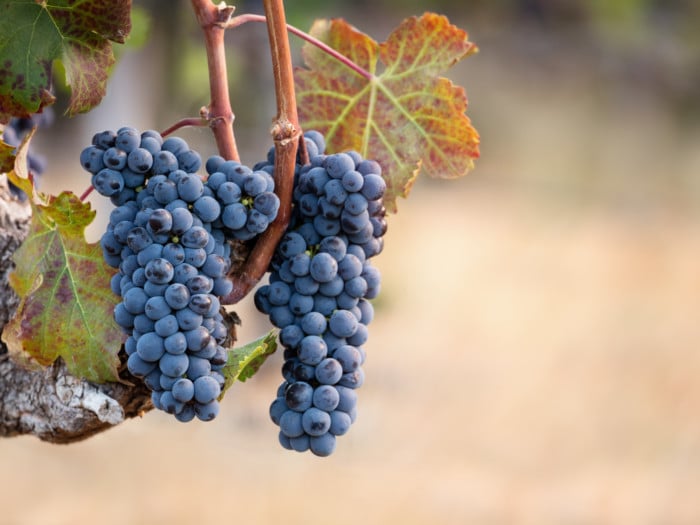Although all types of grapes offer something special, all the different types of grapes also offer slight variances in size, color, taste, and use, as well as growth patterns. There are thousands of different subspecies and cultivars of grapes, but knowing these basic, mainstream variants is a good place to start.
Different Types of Grapes
The most popular and common types of grapes include sultana, moon drops, cotton candy, Concord, Canadice, fry muscadine, pinot noir, Lemberger, sweet jubilee, valiant, champagne, crimson seedless, and Riesling, among others. [1]
Sultana
Found in the area around the Aegean Sea, sultanas are small, white seedless grapes that are often shriveled in appearance. These golden grapes are deliciously sweet and are still a popular ingredient in granola, muesli, and other bran-based cereals in the Middle East. There are also American sultanas, a slightly different variety, and the most widely grown type of grape in California. [2]
Moon Drops
These are a recent addition to the varieties of grapes that are available in America and is the result of cross-cultivation with older varieties of grapes from the Middle East. Extended and oval, these grapes resemble stuffy fingers and have a dark, purple exterior. Their texture is dense and crunchy, and they are quite hardy, lasting for weeks in storage without losing their flavor and nutritional value.

There are more than 10,000 types of grapes. Photo Credit: Shutterstock
Cotton Candy
Harvested from August through September, this California cultivar is so named because it has a surprisingly accurate flavor of cotton candy. These plump green grapes were not specifically designed to taste like the popular carnival snack, but the similarity is undeniable.
Concord
Perhaps one of the most famous types of grapes, primarily due to their connection with grape jelly, Concord grapes are small, dark purple, round grapes that are used as table grapes, as well as grapes for juice and wine. This species is named Vitis labrusca and contains a large seed; these are also slip-skin grapes, meaning it is easy for the skin to be separated from the flesh inside. [3]
Candice
Ripening from September to October, the Candice grape is small, round, and bright red. These grapes have a bit of a spicy bite and come in rather tight clusters. It is used as a table grape and is considered quite hardy, able to retain its flavor and nutritional value for up to 4 months when stored properly. [4]
Fry Muscadine
One of the most unusually shaped grape cultivars, fry muscadine grapes are large, golden-brown, and round, often resembling a larger fruit than a grape. However, once they ripen and take on a slightly burnt yellow or orange color, they are a deliciously sweet, oversized variety of grape. [5]
Pinot Noir
Named for the wine that has made these grapes famous, these small, round grapes take on a bright blue color as they ripen, finishing as a deep purple. Named for the two French words, “pine” and “black”, these are some of the most commonly grown grapes in France, and they ripen in August and September. They are also widely grown in California, New Zealand, and Oregon. [6]
Lemberger
When these grapes are ready to be harvested in August and September, Lemberger grapes have a muddled blue color with a rather heavy “bloom” – the natural white sheen that certain grapes take on. These grapes have a spicy aftertaste and are often used to make subtle and spicy wines. These grapes are most commonly grown in Germany and upstate New York. [7]
Sweet Jubilee
Grown in central California, sweet jubilee grapes are surprisingly large, and are dark purple to black. Looking as though they are always about to burst, you can slice these grapes open to remove the large seed, and then enjoy the rich, sweet flavor.
Valiant
These cold-weather grapes are often harvested in Alaska and Canada and are large and blue in appearance. They are commonly used as table grapes and in the production of wine and are known for their hardiness and ability to survive low temperatures. [8]
Champagne
Also known as the Zante currant, this small grape is only about the size of a pea and is therefore used as a garnish for other dishes, thanks to its surprisingly sweet taste. It is also known as a black Corinth grape in certain parts of the world. [9]
Kyoho
Known as the largest grapes, these bulbous red grapes can grow to the size of the plum. Found in Japan, you will need to peel these grapes and remove the large, inedible seed before you can enjoy the delicious fruit. [10]
